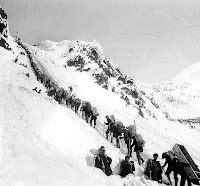On one of our many trips to Alaska to
visit family, my husband and I had the opportunity to take the train to
Fairbanks, learn about the Klondike Gold Rush, and try our hand at panning for
gold.
 |
| Gold flakes left from panning |
The Klondike Gold Rush was a migration
of an estimated 100,000 prospectors to the Klondike region of the Yukon in
northwestern Canada between 1896 and 1899. Gold was discovered on August 16,
1896. When the news reached Seattle and San Francisco the following year, it
triggered a stampede of prospectors.
In order to prevent starvation, Canadian
authorities required each prospector to have a year’s supply of food along with
their panning equipment before they started through the ports of Dyea and Skagway
in Southeast Alaska. They could then follow either the Chilkoot or White Pass
Trails to the Yukon River and sail down to the Klondike. Since all their
equipment weighted close to a ton, it had to be carried in stages. Often,
because of the mountainous terrain and cold climate, those who persisted didn’t
arrive until summer 1898.
 Gold panning is supposedly a simple process. Once a
suitable placer deposit is located, alluvial deposits are scooped into a flat
pan, where they are then gently agitated forcing the gold flakes to sink to the
bottom of the pan. The gold pan is now most commonly used to locate a richer
paying area by sampling, so that larger production equipment can be brought
into the locations to work the ground to recover the gold. Almost all gold
mining today is performed with modern heavy equipment.
Gold panning is supposedly a simple process. Once a
suitable placer deposit is located, alluvial deposits are scooped into a flat
pan, where they are then gently agitated forcing the gold flakes to sink to the
bottom of the pan. The gold pan is now most commonly used to locate a richer
paying area by sampling, so that larger production equipment can be brought
into the locations to work the ground to recover the gold. Almost all gold
mining today is performed with modern heavy equipment.
However, panning is not as simple as you might
think. Once you have the silty material in your pan with the water included,
you must get the heavy gold particles to settle to the bottom of the pan by
vigorously shaking the sediment-water mixture, then reducing the residue in the
pan by gently washing off the top layers of material.
 |
| Heading up the Chilkoot Pass |
Paige, my daughter-in-law, and I found that
there is much more to this process than meets the eye. The process of settling
the gold to the bottom, holding the pan at the correct angle, and washing away
the sedimentary top materials is not as easy as it looks. Luckily for me, a
young man who was a tour guide at the dig, showed us how to do it. Actually, he
took the pan from my inept hands and helped me get to the gold.
Collectively, my husband, my son, Paige
and I panned about $35.00, but decided to put all the flakes into a pendant which
we gave to Paige. Yes, we had to buy the pendant. See how easily tourists are
easily hoodwinked into parting with their hard-earned cash?
Now, every time I read a novel about
early settlers panning for gold, I think to myself—good luck with that!
For a chance to #WIN an #ECHODOT or #KINDLE Fire, please check out the tasks on the Rafflecopter Link below. Mine is the fifth task down. "Follow Judy Ann Davis on Bookbub."
http://www.rafflecopter.com/rafl/display/e226730a31/? - GOOD LUCK! Ending February 4th.

Judy, sorry to be late commenting. Your post reminded me of Maggie Osbourne's book, I DO, I DO, I DO. I'm envious that you were able to go to Alaska. For years, my husband and I have wanted to go.
ReplyDelete